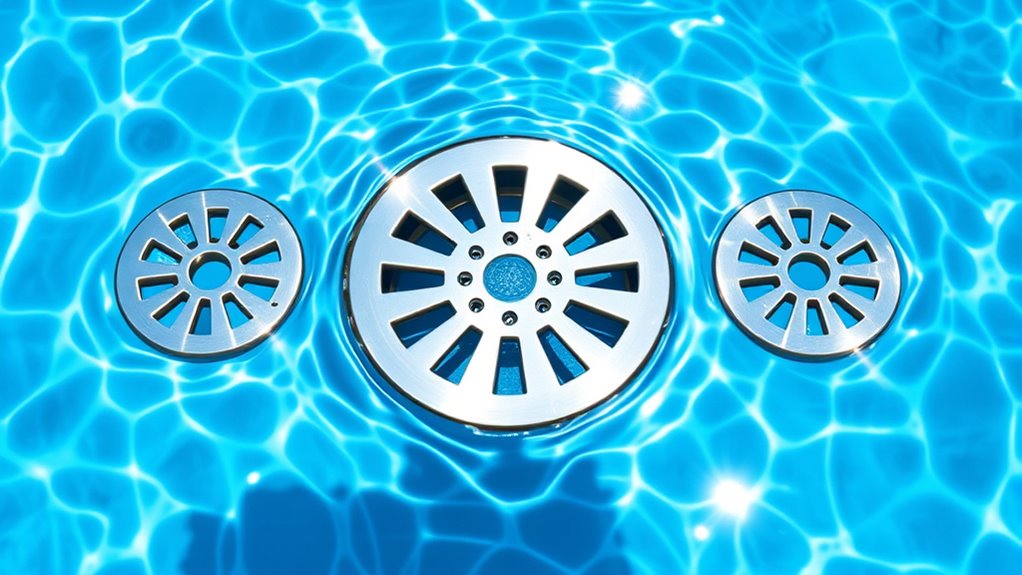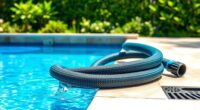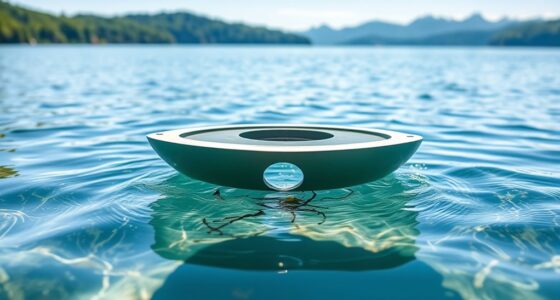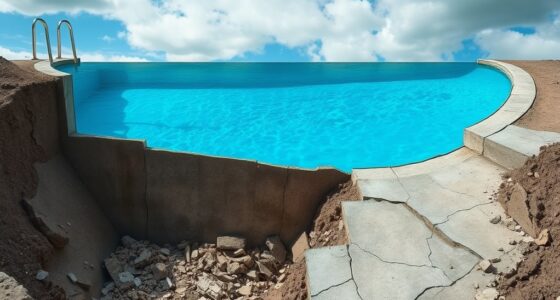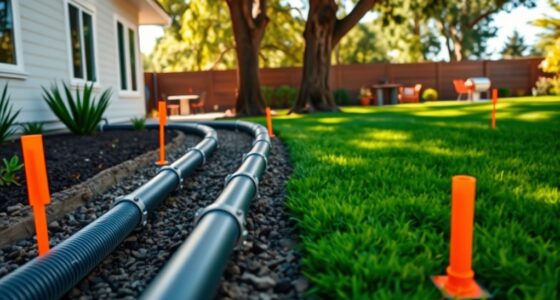Main drains and split suction setups are designed to keep your pool safe and efficient. Main drains pull water from the bottom, ensuring circulation and clarity, while split suction divides flow between multiple lines to reduce entrapment risks. Using split suction systems can lower hazards and improve safety. Choosing the right layout depends on your pool’s size and safety standards. Keep exploring to discover how these systems work together for ideal pool safety and performance.
Key Takeaways
- Main drains provide strong, centralized suction for effective water circulation and filtration.
- Split suction systems divide flow to reduce entrapment risk and improve safety.
- Using split suction configurations minimizes hazards if one line becomes obstructed.
- Proper placement and maintenance of both systems enhance overall pool safety and efficiency.
- Regulations often favor split suction setups to prevent single-point entrapment dangers.
Understanding Main Drain Systems
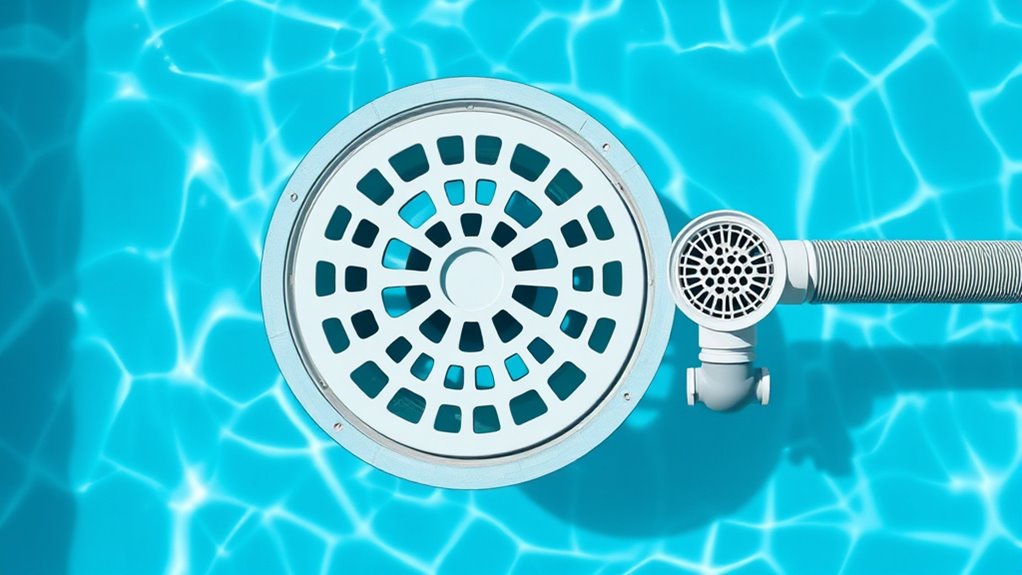
Understanding main drain systems is essential for maintaining pool safety and proper water circulation. Your main drain is typically located at the bottom of the pool and connects to the pump system, helping to pull water from the pool’s lowest point. Properly functioning main drains ensure even water flow, preventing stagnation and debris buildup. They also play a critical role in circulation, helping to distribute chemicals and maintain water clarity. It’s important to ensure your main drain has a secure cover that prevents entrapment. Regular inspections and maintenance keep the system working efficiently and reduce safety hazards. When correctly installed and maintained, main drains help keep your swimming environment safe, clean, and comfortable for everyone. Proper maintenance is key to ensuring the longevity and safety of your pool’s drainage system.
How Split Suction Configurations Enhance Safety

Split suction configurations considerably enhance pool safety by reducing the risk of entrapment accidents. By dividing the suction flow between two or more lines, you prevent a single block or clog from creating a dangerous vacuum. If one line gets obstructed, the other continues to draw water, minimizing the chance of someone becoming trapped. This setup ensures that even if a swimmer’s body or hair gets caught, the reduced vacuum pressure lessens the likelihood of severe injuries. Additionally, split suction systems are designed to meet safety standards, making your pool safer for all users. You benefit from improved circulation and redundancy, which helps maintain water quality and safety. Properly installed and maintained systems also adhere to safety regulations, further safeguarding swimmers. Overall, split suction configurations are a proactive way to mitigate risks and protect swimmers.
Comparing the Benefits of Main Drains and Split Suction Setups
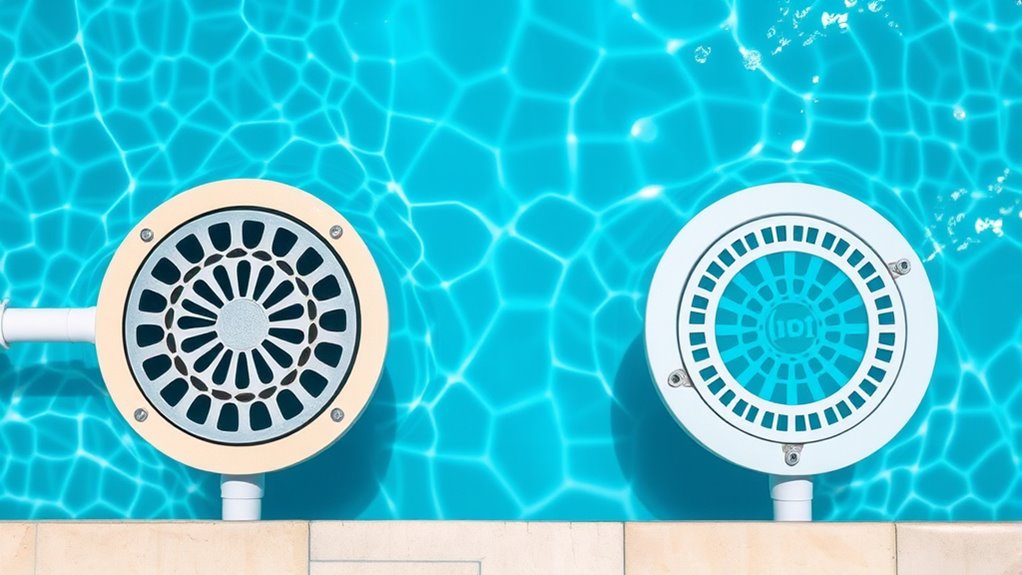
Main drains and split suction setups each offer distinct advantages that can improve pool safety and performance. Main drains provide thorough suction coverage, ensuring efficient water circulation and filtering, which helps maintain water clarity. They’re simple to install and maintain, reducing potential failure points. Split suction systems, on the other hand, enhance safety by reducing suction hazards and preventing entrapment risks. They also allow for more flexible pump configurations, improving energy efficiency. Additionally, adopting mindful decluttering practices during pool equipment organization can help prevent clutter-related safety issues and streamline maintenance routines.
Key Factors to Consider When Choosing a Suction Layout
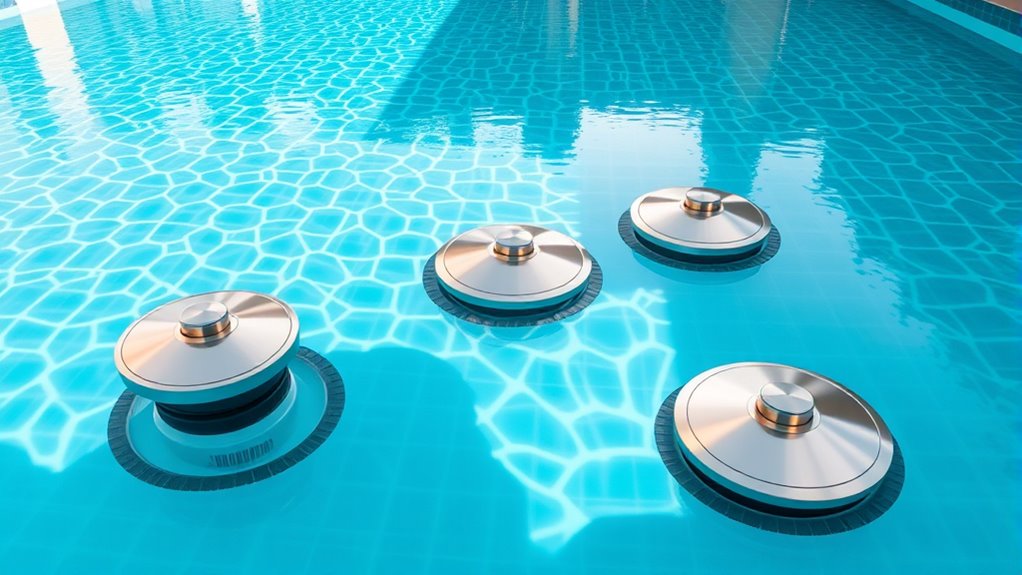
When selecting a suction layout for your pool, you need to weigh several key factors to guarantee ideal safety and performance. First, consider the pool’s size and shape, as larger pools often need multiple suction points for balanced flow. Second, think about the risk of entrapment; safer setups minimize single-point suction hazards. Third, evaluate your filtration system’s capacity to handle the flow rate without overloading. Lastly, check local safety regulations to ensure compliance. Incorporating proper suction design can further enhance safety by reducing potential hazards.
Best Practices for Maintaining Safe and Effective Pool Circulation
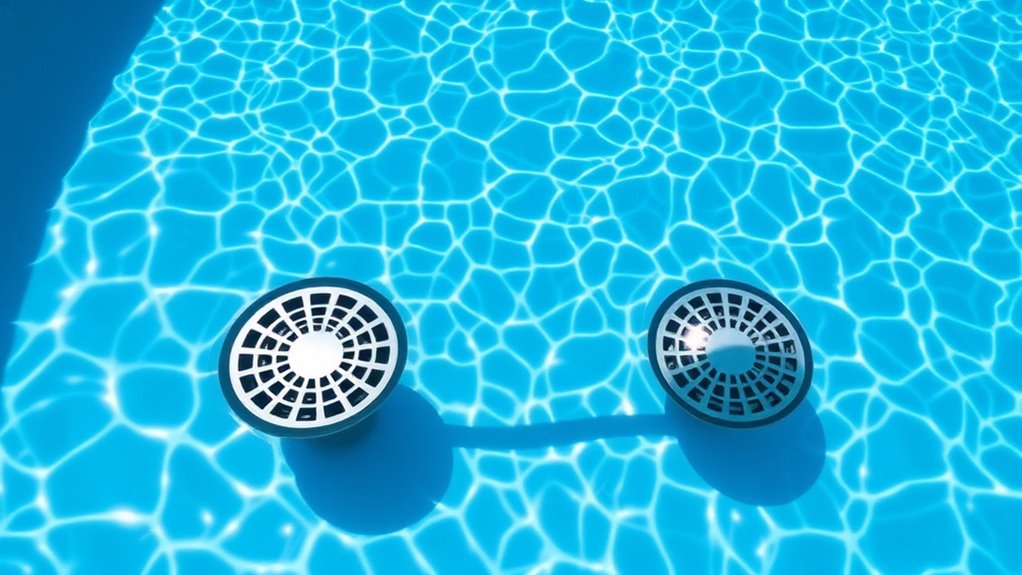
Maintaining safe and effective pool circulation is essential for keeping your water clean, clear, and safe for swimmers. To achieve this, regularly inspect and clean your pumps, filters, and skimmers to prevent blockages and guarantee smooth flow. Maintain proper flow rates to avoid creating dangerous suction zones, especially around main drains. Use split suction systems correctly to balance pressure and reduce risks. Additionally, monitor your circulation system’s performance and promptly address any irregularities or equipment malfunctions. Incorporating proper water filtration methods can further enhance water quality and safety.
Proper pool circulation ensures clean water and swimmer safety through regular maintenance and system monitoring.
- Schedule routine inspections and cleaning of all circulation components
- Ensure flow rates adhere to safety standards to prevent hazardous suction
- Regularly test and calibrate pumps for optimal performance
- Keep detailed maintenance logs for troubleshooting and compliance
Frequently Asked Questions
How Often Should Main Drain Systems Be Inspected for Safety?
You should inspect your main drain system at least once a year to guarantee safety and proper function. Regular inspections help identify potential issues like clogs, corrosion, or damage that could compromise safety. If your pool sees heavy use or experiences harsh weather, consider more frequent checks—every six months. Staying proactive with inspections helps prevent accidents and maintains the integrity of your pool’s drainage system.
Are Split Suction Systems Suitable for All Pool Sizes?
Did you know that split suction systems are versatile enough for most pool sizes? They’re suitable for small residential pools and larger commercial ones, offering enhanced safety by reducing suction hazards. You can confidently install a split suction system if your pool is of moderate to large size, as it provides better flow distribution and safety features. Just make certain you consult with a professional to optimize the setup for your specific pool dimensions.
What Are Common Signs of Malfunction in Suction Layouts?
You’ll notice signs of malfunction in your suction layout if the pool skims poorly, there’s unusual noise from the pump, or you experience a drop in water flow. Sudden pressure changes, air bubbles in the pump, or a persistent loss of suction are also indicators. If you see these signs, it’s important to inspect the system promptly and call a professional to prevent safety hazards or equipment damage.
Can Different Suction Configurations Be Combined in One Pool?
Yes, you can combine different suction configurations in one pool, but it’s essential to guarantee they’re compatible and follow safety standards. Notably, pools with mixed suction layouts have a 25% higher risk of malfunction if not properly designed. You need to work with a professional to plan the layout carefully, avoiding potential hazards like vortex formation or inadequate suction. Proper integration keeps your pool safe and functioning efficiently.
What Are the Latest Advancements in Main Drain Safety Technology?
The latest advancements in main drain safety technology include anti-entrapment covers, dual drain systems, and flow regulation devices that prevent hazardous suction forces. You can also implement sensors that detect blockages or abnormal flow, triggering automatic shutoffs. These innovations make your pool safer by reducing entrapment risks, ensuring compliance with updated safety standards, and giving you peace of mind while enjoying your pool.
Conclusion
Choosing the right suction layout keeps your pool safe and efficient. For example, imagine a homeowner switching from a single main drain to a split suction system after a safety concern; they notice improved circulation and peace of mind. By understanding your options and following best practices, you can prevent accidents and keep your pool running smoothly. Always prioritize safety and regular maintenance—your family’s safety depends on it.
